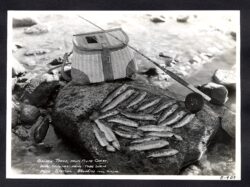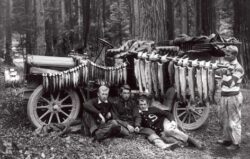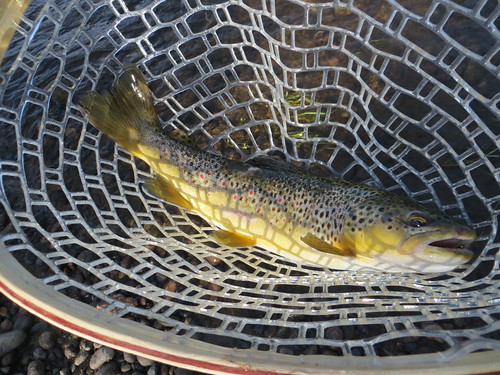Montana fisheries are being overfished. Many anglers practice Catch and Release fishing. Trout, walleyes, or perch are hooked, landed, and released often after several minutes of selfies, flipping, flopping, and handling. Fish are often dropped into the dirt or gravel. None of this helps the fish.
Once a fish is hooked, the clock starts running. The battle begins and the fish is fighting for its life. Lactic acid begins building up in the fish’s muscles. On warm water, and hot summer days, the stress is worse. Most skilled fishermen should be able to hook, fight, land, and release a fish in 5 minutes.
If it is taking you longer than 5 minutes to land a fish, you are killing it. Cellphone picture sessions require more time and stress on the fish. It may swim away but the damage is done. The tired and distressed fish will stop feeding, get preyed upon by a raptor or predator, develop bacteria and fungal growths where their protective mucous has been wiped off their bodies. Bigger fish have a harder time recovering from the stress of being caught.
The MTFWP does set Hoot Owl Restrictions on fisheries when the water warms in late summer. Catch and Release restrictions are also common. Possession limits restrict the number of fish an angler can remove and consume from the fishery. Barbless hooks do not directly impact hooked fish. Forceps, rubber nets, and handling procedures are important. Sadly, little is done to discourage over fishing and over catching.
Trout and other fish can only get caught and released so many times before they pay a fatal price. Studies show that when trout are caught and released, using proper Catch and Release techniques, nets, and forceps, they can be recaught from 4-6 times. Every hooked encounter is one less life.
What if fishermen were limited to a certain number of hook ups? These Catch Limits would limit how many fish can be Hooked, landed, and released. Once the Catch Limit is reached, the fishing is done for the day. The truth is that 10% of anglers will catch 90% of the fish. This number increases when a guide or experienced mentor is involved.
Guides, and outfitter clients, often catch the most fish. It would make sense that they would want to protect the fishery and their livelihood. Catching dozens of fish, a day is more abusive than sporting. The guides are on the water more often and have figured out how to get more hook ups and tight line encounters.
Once the Guide has landed a Catch Limit for their clients, the attention will now fall onto the anglers not catching fish. The Limited-Out angler can now learn to row the boat, net, photograph, or support others. Learning new skills is also desirable for clients.
Ripping Lips sounds like what it is. Even with the right nets, skills, forceps, hooks, and training. The average Catch and Release angler will kill or injure 10% of fish that they catch. If a guide has 2 fishermen in their boats a day, and they catch 20 fish each a day/ 40 per boat, that means 4 dead trout on each trip. If the guide fishes 5 days a week, that’s 20 dead trout a week. Multiply that catch times 20 guide trips, and that’s 400 dead trout a week, which adds up to 1,600 trout /month! In a fishery where there are say 2,500 trout, of all sizes, /mile, that’s a huge mortality. Some fishermen also keep fish to eat. These fish are now out of the ecosystem permanently. That’s why possession limits exist.
This doesn’t include the shore fishermen, and exorbitant numbers of boats we currently see on the Madison River during the major hatches. Montana’s major Blue Ribbon Fisheries exceed 100 guide trips/ boats a day. Thank goodness not all fishermen and guides are great at catching fish.
Natural predators also take their limits of fish. Pelicans eat up to 6 fish per day! Eagles and other raptors often target fish. Kingfishers, giant water bugs, and other critters in the ecosystem also take their toll. Exhausted, released fish often fall to these predators.
Let’s say that the Catch Limit is required on the Madison River. The daily Catch Limit is 20 trout. A good fishermen would require at least 3-6 hours of fishing time to hook and release that many fish. Usually, fishing action happens in spurts and is not consistent. That’s a great day of fishing. The impact on dozens of other fish is now limited. Drifts and trips can be shorter and take the pressure off the rivers. There will be more fish next time the angler or guide hits the water. Boat ramp crowds and river traffic will be decreased.
Trout fishing in Montana means big bucks, and the fish are paying the bills. Overpopulation is not the problem for most Blue Ribbon Trout fisheries. If fish die, the number of potential hook ups dies with them. Fish can die diseases, pollution, warm water, and for many other reasons. Restocking would add more fish, but most anglers prefer Wild or Native fishing experiences. That’s great but we may need to sacrifice something to ensure that our fisheries remain healthy. 20 fish a day is a great day of fishing! Even if there are no regulations to enforce Catch Limits, this idea is a common sense, positive, personal choice.
Montana Grant



